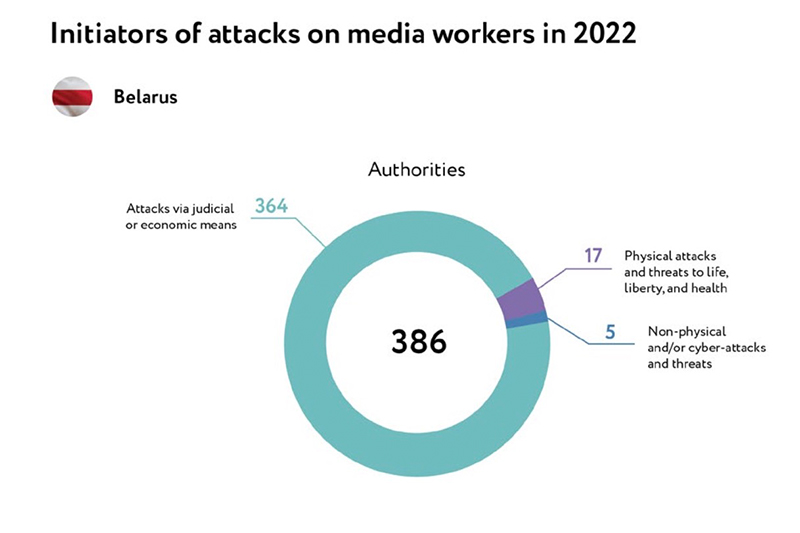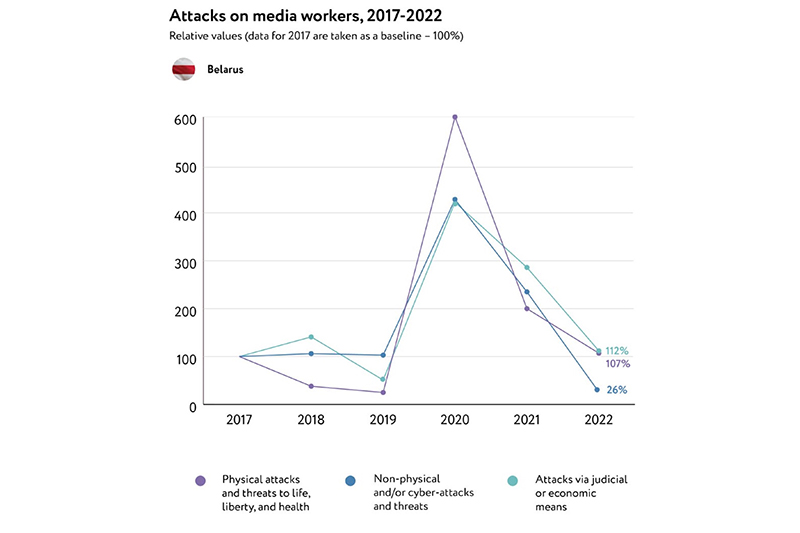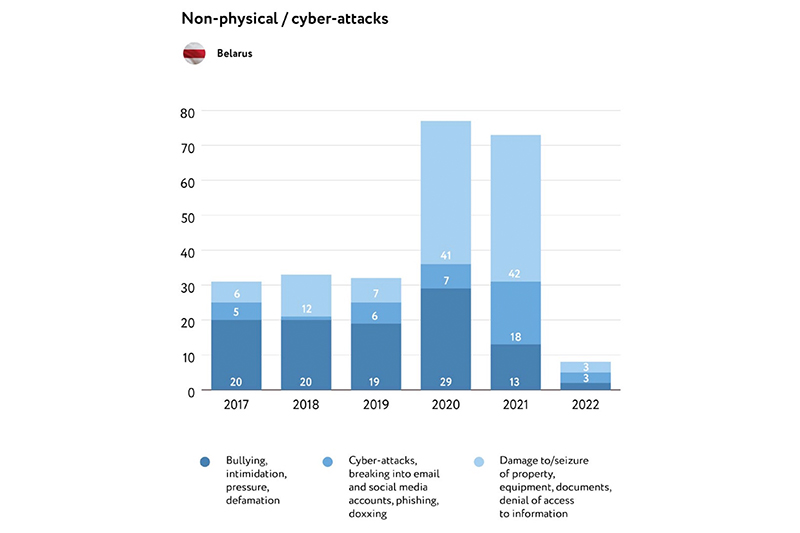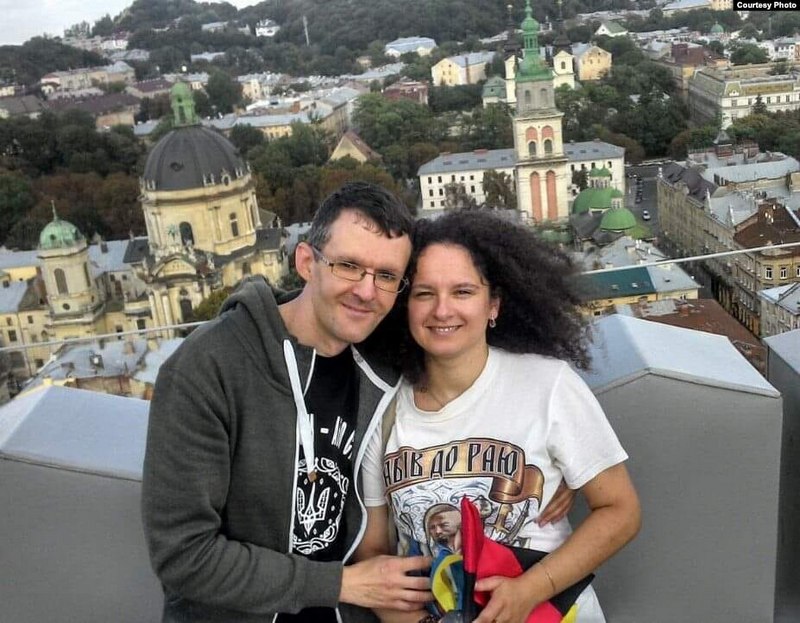“Turkmenization is underway in Belarus.” Experts comment on situation with independent journalism in Belarus based on new BAJ and JFJ report
Since the suppression of the 2020 protests, the number of attacks on journalists and the media has declined, but the nature of the attacks has become more violent. In 2021 and 2022, the total number of reported cases was 1,432, compared with 1,558 in 2020, according to a report presented in London by BAJ and the Justice for Journalists Foundation.
Download the report in English
“The perpetrators are predominantly public officers”
The speakers, who included media experts, human rights activists, and politicians, acknowledged that the situation in Belarus has been overshadowed by the war in Ukraine. However, it demands the attention of the international community because of the brutal repression of civil society and journalism.
British human rights activist Baroness Helena Kennedy assured:
“For our part, we continue to monitor the situation in Belarus. We pay particular attention to violations of freedom of speech and the rights of independent journalism. We do our best to support the media and restore justice”.
According to the authors of the report, attacks via judicial and/or economic means were the most common method of exerting pressure on media workers. Such attacks accounted for 90 percent of the total in 2021 and approximately 94 percent in 2022.
“This year the Belarusian Association of Journalists was recognized as an extremist formation, and a few days ago our website, social media pages, and even logo were declared extremist. So you are now listening to an extremist, and sharing this report in Belarus entails criminal liability,” BAJ chairman Andrei Bastunets commented ironically on the latest actions of the regime.

He stressed that the decrease in the overall number of attacks is linked to the so-called Turkmenization of Belarus: there are fewer legally working journalists in the country to be persecuted. Some have been arrested, others have fled the country and others have left the profession.
“The perpetrators are predominantly public officers, and this is characteristic of what is happening in Belarus,” said the head of the BAJ.

Journalists are given harsher punishments than murderers
The criminalization of journalism continues. Criminal penalties for media workers, the report notes, have become more severe. In particular, reporters are being sentenced to terms longer than those for violent crimes such as murder.
“In terms of media freedom, Belarus is on a par with such countries as Azerbaijan and Afghanistan,” said Maria Ordzhonikidze, director of the Justice for Journalists Foundation.
She pointed out that the websites of many independent media in Belarus are blocked on such far-fetched pretexts as discrediting the authorities, inciting social hatred, and others, which is very similar to the situation in other countries with the most brutal dictatorial regimes.

This is confirmed by the data indicated in the report. The number of cases related to media closures, obstruction of print publications, and restricting access to online media has increased significantly even in comparison with 2020.
“Belarus could be an example of how a dictatorship develops in the absence of independent media and a suppressed civil society,” noted Robert Seely, a member of the British Parliament.
The most frightening thing is that not all cases of harassment of press representatives are in the public eye. The report says that often journalists and their families are afraid to disclose attacks after intimidation by security forces.
Sometimes reporters consider certain types of rights violations, such as restricting access to information, to be insignificant and therefore do not report them.
The harassment continues even behind bars
Of great concern is the pressure exerted on journalists (currently 30+ media workers are behind bars in Belarus) while they are in custody.
“Political prisoners, including journalists, are placed in overcrowded cells,” the report states, “deprived of basic amenities such as bedding and hygiene products, subjected to violence, kept in the cold without warm clothing, strip-searched, deprived of sleep and the ability to contact relatives and denied medical care”.
Another method of pressure that the authors of the report point out is the publication of “repentant” videos of imprisoned journalists, apparently recorded under duress.
These videos are then broadcast on state television and pro-government Telegram channels.
“According to Reporters Without Borders, Belarus ranks fifth in the number of imprisoned journalists and fourth in the number of female journalists,” empathized Andrei Bastunets.
Raids are just one of many forms of harassment
The state persecution is not limited to arrests and detentions of independent media workers.
Recently, the main methods of pressure on journalists have been deprivation of access to information, harassment, intimidation, death threats, and hacking into journalists’ social media accounts, the report concludes.
According to the report’s authors, the number of cyber attacks, including hacks of journalists’ emails and Telegram channels, has risen sharply.
RFE/RL Belarus, Nasha Niva, Onliner, Charter 97, Narodnaya Volya, Brestskaya Gazeta, Avtobiznes, and others were subjected to such attacks.

In addition, journalists have faced constant undue obstruction of their professional duties during court sessions.
Last year the number of such cases decreased, but only because of the ‘Turkmenization” process.
“The media sector has shown tremendous resilience and ability to resist”
According to Robert Seely, the Kremlin has long used Belarus as a platform for Russian propaganda.
“The suppression of protests in 2020 was a consequence of Russia’s long-standing takeover,” said the British MP.
Belarus, he added, has become a springboard for testing political technologies for Moscow, and the practices tested have been quite successful.
“Belarus used to have a strong media sector,” said Maria Sadouskaya-Komlach, head of Free Press Unlimited. “But when the regime expelled so many journalists, the country had no sources of information other than the state media. And those who find themselves outside the country have to start practically from scratch.”
Experts agree that countering propaganda remains the most important goal of the independent media now operating in exile.
“But it is only possible to put pressure on something that resists,” Bastunets concluded. “The media sector has shown tremendous resilience and ability to resist.”
Read more:
Tatsiana Pytsko extends the list of media representatives behind bars in Belarus. Now it counts 34 journalists
“We stand in full solidarity with our brave colleagues!” The IFJ keeps torch of solidarity with journalist prisoners burning
 @bajmedia
@bajmedia

